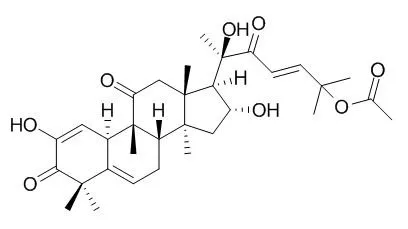| Description: |
Cucurbitacin E has prevention of neurodegeneration, it has potent anti-proliferative, antineoplastic, anti-inflammatory and analgesic actions, it also exhibits immunosuppressive effect by attenuating critical cytokine expression through down-regulating the NF-κB signaling pathway. |
| Targets: |
IL Receptor | VEGFR | JAK | STAT | ROS | NF-kB | p38MAPK | TNF-α | p65 | ERK | Caspase | p21 |
| In vitro: |
| nt J Clin Exp Pathol. 2013 Aug 15;6(9):1799-805. | | Growth inhibitory effect of Cucurbitacin E on breast cancer cells.[Pubmed: 24040444] | Due its inhibitory effects on chemical carcinogenesis and inflammation, Cucurbitacins have been proposed as an effective agent for the prevention or treatment of human cancers. In this study, we aimed to explore the effect of Cucurbitacin E (CuE) on human breast cancer cells.
METHODS AND RESULTS:
The inhibitory effect of CuE on proliferation of Bcap37 and MDA-MB-231 cells was assessed by MTT assay. The cell cycle distribution and cell apoptosis were determined by flow cytometry (FCM). The expression of pro-caspase 3, cleaved caspase 3, p21, p27 and the phosphorylation of signaling proteins was detected by Western Blotting.
CuE inhibited the growth of human breast cancer cells in a dose and time-dependent manner. FCM analysis showed that CuE induced G2/M phase arrest and cell apoptosis. CuE treatment promoted the cleavage of caspase 3 and upregulated p21 and p27. In addition, the phosphorylation of STAT3 but not ERK-1/2 was abrogated upon CuE treatment. Interestingly, losedose CuE significantly enhanced the growth inhibition induced by cisplatin.
CONCLUSIONS:
Cucurbitacin E (CuE) could inhibit the growth of human breast cancer cells in vitro. CuE induced both apoptosis and cell cycle arrest probably through the inhibition of STAT3 function. Lose-dose CuE significantly enhanced the growth inhibitory effect of cisplatin on breast cancer cells, further indicating the potential clinical values of CuE for the prevention or treatment of human breast cancer. | | Phytochemistry, 1977, 16(10):1519-22. | | Cucurbitacin E and I in Iberis amara: Feeding inhibitors for Phyllotreta nemorum.[Reference: WebLink] | Cucurbitacin E and cucurbitacin I have been isolated from green parts of Iberis amara and identified by TLC, UV and MS.
METHODS AND RESULTS:
It is shown that cucurbitacins act as feeding inhibitors for the flea beetle Phyllotreta nemorum. The most potent feeding inhibitors in green parts of I. amara towards P. nemorum are Cucurbitacin E and I, and the concentrations of these compounds in the plant are found to be high enough to prevent feeding of the flea beetle. |
|
| In vivo: |
| Carcinogenesis. 2010 Dec;31(12):2097-104. | | Cucurbitacin E, a tetracyclic triterpenes compound from Chinese medicine, inhibits tumor angiogenesis through VEGFR2-mediated Jak2-STAT3 signaling pathway.[Pubmed: 20732905 ] | Cucurbitacin E (CuE, α-elaterin), a tetracyclic triterpenes compound from folk traditional Chinese medicine plants, has been shown to inhibit cancer cell growth, inflammatory response and bilirubin-albumin binding. However, the effects of CuE on tumor angiogenesis and its potential molecular mechanism are still unknown.
METHODS AND RESULTS:
Here, we demonstrated that CuE significantly inhibited human umbilical vascular endothelial cell (HUVEC) proliferation, migration and tubulogenesis in vitro and blocked angiogenesis in chick embryo chorioallantoic membrane assay and mouse corneal angiogenesis model in vivo. Furthermore, we found that CuE remarkably induced HUVEC apoptosis, inhibited tumor angiogenesis and suppressed human prostate tumor growth in xenograft tumor model. Finally, we showed that CuE blocked vascular endothelial growth factor receptor (VEGFR) 2-mediated Janus kinase (Jak) 2-signal transducer and activator of transcription (STAT) 3 signaling pathway in endothelial cells and suppressed the downstream protein kinases, such as extracellular signal-regulated kinase and p38 mitogen-activated protein kinases.
CONCLUSIONS:
Therefore, our studies provided the first evidence that CuE inhibited tumor angiogenesis by inhibiting VEGFR2-mediated Jak-STAT3 and mitogen-activated protein kinases signaling pathways and CuE is a potential candidate in angiogenesis-related disease therapy. | | Planta Med. 1997 Dec;63(6):525-8. | | Anti-inflammatory and analgesic effects of cucurbitacins from Wilbrandia ebracteata.[Pubmed: 9434604 ] | The anti-inflammatory and antinociceptive actions of the CH2Cl2 extract and semipurified fraction (F-III) from roots of Wilbrandia ebracteata Cogn. have been investigated in rats and mice.
METHODS AND RESULTS:
The CH2Cl2 extract (1-10 mg/kg, i.p.; ID50 5 mg/kg) and (3-30 mg/kg, p.o.; ID50 15 mg/kg) inhibited, in a dose-related manner, carrageenan-induced paw edema in rats. The subfraction (F-III) from CH2Cl2 extract and compounds isolated as cucurbitacin B and Cucurbitacin E also inhibited carrageenan-induced edema. The CH2Cl2 extract and F-III also exhibited significant analgesic action in acetic acid-induced pain in mice. In the formalin test, the CH2Cl2 extract (0.3-10 mg/kg, i.p.) and (3-30 mg/kg, p.o.) caused inhibition of the neurogenic (first phase) and inflammatory phase (second phase) of formalin-induced pain. However, the CH2Cl2 extract was more effective in relation to the second phase than in inhibition of the formalin-induced edema.
CONCLUSIONS:
These findings suggest that CH2Cl2 extract has potent anti-inflammatory and analgesic action and that F-III and cucurbitacin B and Cucurbitacin E may account for these actions. |
|






 Cell. 2018 Jan 11;172(1-2):249-261.e12. doi: 10.1016/j.cell.2017.12.019.IF=36.216(2019)
Cell. 2018 Jan 11;172(1-2):249-261.e12. doi: 10.1016/j.cell.2017.12.019.IF=36.216(2019) Cell Metab. 2020 Mar 3;31(3):534-548.e5. doi: 10.1016/j.cmet.2020.01.002.IF=22.415(2019)
Cell Metab. 2020 Mar 3;31(3):534-548.e5. doi: 10.1016/j.cmet.2020.01.002.IF=22.415(2019) Mol Cell. 2017 Nov 16;68(4):673-685.e6. doi: 10.1016/j.molcel.2017.10.022.IF=14.548(2019)
Mol Cell. 2017 Nov 16;68(4):673-685.e6. doi: 10.1016/j.molcel.2017.10.022.IF=14.548(2019)